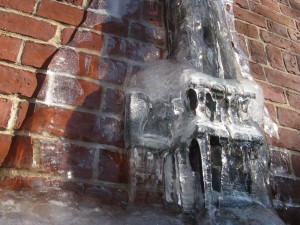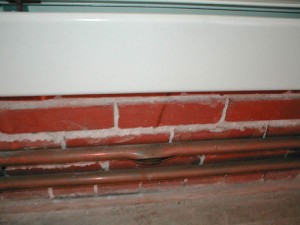 Even though winter is almost over, some areas are still experiencing freezing temperatures, snow and ice. With the combination of extreme cold and wind chill, the winter months are especially hard on pipes. Even the smallest of cracks in a pipe can cause your home to flood in a day, but with careful preparation you can prevent frozen pipes and avoid potential damage.
Even though winter is almost over, some areas are still experiencing freezing temperatures, snow and ice. With the combination of extreme cold and wind chill, the winter months are especially hard on pipes. Even the smallest of cracks in a pipe can cause your home to flood in a day, but with careful preparation you can prevent frozen pipes and avoid potential damage.
Tips for preventing frozen pipes
Help prevent frozen pipes by doing the following:
- Open cabinet doors under sinks and in storage areas to allow heat from the room to circulate around exposed pipes.
- Insulate all pipes in nonclimatized areas or against uninsulated outside walls. Apply heat tape or thermostat-controlled heat cables around pipes that are exposed and prone to freezing. (Note: These must be used with extreme caution. Follow the manufacturer’s instructions carefully to avoid the risk of fire.)
- Make sure the heat is turned on and set no lower than 55 degrees Fahrenheit (13 degrees Celsius).
- Seal cracks and holes in the outside walls and foundations near water pipes with caulking to keep cold wind away from the pipes.
- Check the pipe fittings. Compression fittings can sometimes break loose from the expansion and contraction of the pipes.
If you have frozen pipes, follow these tips to help avoid a crack:
- Shut off the water main leading into the facility to reduce pressure on frozen pipes and minimize flooding if the pipes burst.
- Take your time when thawing out your pipes. Use warm water, warm-soaked towels or a hand-held dryer.
Another idea to keep pipes from freezing is to place a space heater with a thermostat in areas where there is a possible freezing concern. Know where your shutoff valves are in case a problem does occur, identify drainage areas for cleanup, and have a wet/dry vacuum available.
Let’s hope Punxsutawney Phil was right and we’ll see an early spring!
How do you keep your pipes from freezing in the winter? Got any tips you want to share?
Related Posts:
How to Lift Safely and Avoid Common Injuries During Your Move




